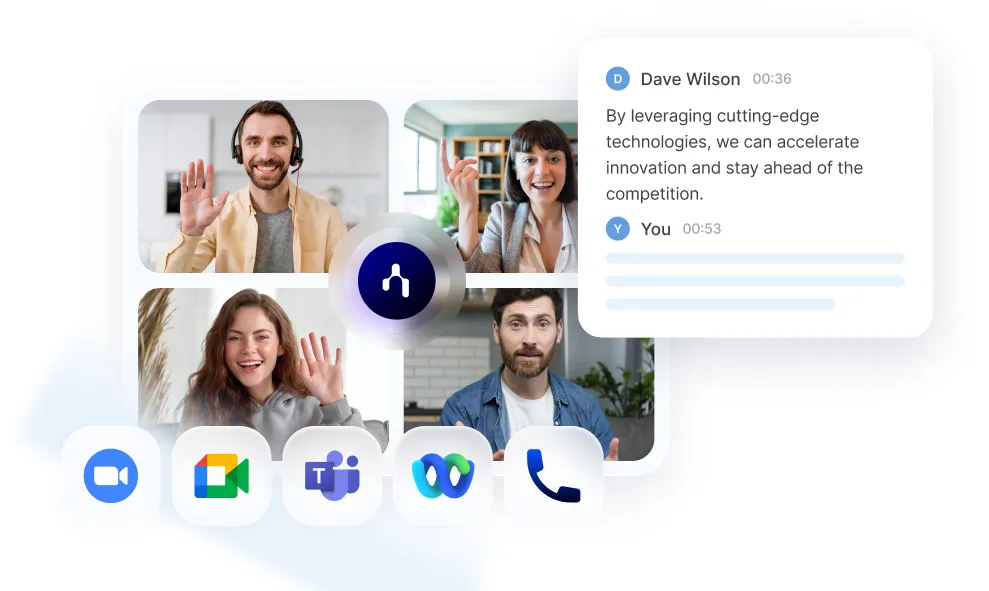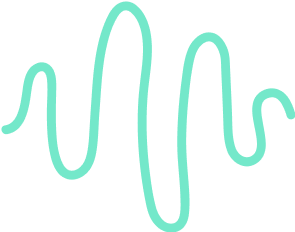Active Listening : Best Practices with Examples

Get the work done for any meeting
Meeting transcription, AI custom notes, CRM/ATS integration, and more
Ever catch yourself nodding along in a conversation—while mentally drafting your next email or thinking about your to-do list?
Active listening is your most powerful communication skill.
In this article, you’ll learn what true active listening looks like in practice.
What true active listening looks like
True active listening is the practice of fully engaging your attention, your thoughts, and even your emotions with the speaker.
When you actively listen, you demonstrate clear signs of genuine interest. You maintain eye contact, nod to show understanding, and use body language that signals openness. You don’t glance at your phone or emails. Your attention stays fully with the person speaking.
There are clear signs when active listening is happening:
- Reflective statements: You summarize what you’ve heard, restating key points in your own words to confirm understanding. Phrases like “What I hear you saying is…” or “It sounds like you’re feeling…” are common signals of active listening.
- Clarifying questions: You ask thoughtful, open-ended questions to better understand the speaker’s point of view. “Could you tell me more about that?” or “What made you feel that way?” show your genuine interest.
- Focused attention: Your facial expressions and gestures show engagement. You’re facing the person speaking directly, using affirmative nods or smiles to encourage them to continue.
- Mindful silence: You pause intentionally, giving the speaker space to share more. Comfortable silence signals respect and encourages deeper disclosure.
Active listening builds trust, improves relationships, and reduces misunderstandings.
Cognitive techniques for active listening

Active listening is a skill anyone can master, but it requires practice.
Here are five proven cognitive techniques you can apply immediately:
1. Paraphrasing
Paraphrasing means restating what someone says in your own words.
This does two things: it helps you confirm your understanding, and it signals to the speaker that you’re truly listening.
For example, if a candidate says, "I’m looking for a role that offers more flexibility," you might paraphrase: "So, finding a position with flexible working arrangements is important to you?"
2. Summarizing
Summarizing takes paraphrasing further. You gather key points and present them briefly to verify mutual understanding.
Summarizing is especially useful at natural pauses or at the end of key discussion points. For example, after discussing project tasks, you might say: "So far, we’ve agreed Sarah will lead the research, James handles the presentation, and we’ll revisit timelines next week."
It reinforces alignment and makes sure nothing critical gets overlooked.
3. Reflective listening
Reflective listening involves acknowledging both the content and the emotion behind someone’s words. It shows empathy and encourages deeper sharing.
For example, if a team member says, "I’m feeling overwhelmed by all these deadlines," reflective listening means responding: "It sounds like the workload is stressful and tough to manage right now."
By validating feelings and content, you create trust.
4. Open-ended questioning
Open-ended questions can’t be answered with a simple yes or no. They invite the speaker to share more deeply, expanding your understanding of their perspective.
Questions like "What led you to that decision?" or "How do you feel about the feedback you received?" encourage detailed responses.
They’re especially valuable in recruitment interviews or performance reviews. You gain deeper insights into motivations, challenges, and opportunities.
5. Mindful silence
After someone finishes speaking, wait briefly before replying. Those extra seconds encourage them to continue, clarifying or expanding on their points.
Mindful silence also helps you process information thoroughly. It ensures your responses are thoughtful, not impulsive.
For example, after a team member shares frustration, pause intentionally. Often, they’ll fill that silence with valuable insights or solutions they hadn’t previously mentioned.
Examples of active listening

Let’s walk through four concrete scenarios to illustrate exactly how active listening looks—and feels—in real conversations.
1. Recruitment interview
Imagine you’re interviewing a candidate. You ask, "Tell me about a time when you faced a difficult challenge."
The candidate replies, "In my last role, I struggled with a tight deadline that seemed unrealistic."
Instead of jumping immediately to your next question, you paraphrase and reflect:
"It sounds like that deadline put a lot of pressure on you. How did you handle that situation?"
By doing this, you encourage the candidate to share details about their problem-solving skills and resilience. They feel understood and confident sharing more openly.
2. Employee performance review
An employee says, "I’m feeling stuck in my role—I’m doing the same things every day and it’s becoming draining."
You respond by summarizing their concern and reflecting emotion:
"It sounds like you’re experiencing frustration because your current responsibilities feel repetitive and uninspiring. Can you tell me more about what type of tasks would excite you?"
3. Conflict resolution meeting
Imagine two team members disagree strongly about resource allocation.
Person A says, "I feel like my team’s needs are constantly overlooked."
Person B responds defensively, "That's not true—your team got priority last month."
As a facilitator, active listening involves summarizing both perspectives without judgment:
"It seems one team feels undervalued regarding resource allocation, while the other sees the situation differently based on recent decisions. Let’s clarify where the disconnect is."
Both sides feel heard, enabling a more productive conversation about the actual issue instead of emotions or blame.
4. Virtual team meeting
In remote meetings, distractions easily creep in. Active listening helps keep everyone engaged.
A team member presents updates but their message is unclear. Instead of ignoring confusion or multitasking, you practice active listening and say:
"Just to ensure I’m following correctly—your main point is that we need to revisit our marketing strategy due to recent data changes, correct?"
This paraphrasing shows attentiveness. It also prompts the presenter to clarify or confirm their message.
Additionally, when participants show attentive non-verbal cues—like nodding, maintaining eye contact via camera, or typing thoughtful questions into chat—engagement visibly improves. Speakers feel supported and appreciated, and communication flows more smoothly.
Forget note-taking, focus on the conversation: Noota

Taking notes while actively listening is challenging. Your attention splits between capturing details and genuinely engaging with the speaker. Important information gets missed, and connections suffer.
Noota solves this problem. It’s your AI meeting assistant, designed specifically so you can fully focus on the conversation—not your notes.
Here’s exactly how Noota empowers active listening:
✅ Automatic live transcription
Forget frantic scribbling or typing. Noota captures every word spoken, clearly labeled by speaker. It transcribes your meeting live, accurately recording each moment while you give the speaker your undivided attention.
✅ Instant meeting summaries
Minutes after your meeting ends, Noota provides a clear, concise summary of key decisions, discussion points, and action items. You don’t need to sift through long transcripts. Your next steps and key insights are organized for immediate review.
✅ Action-item detection
Noota’s AI identifies and highlights tasks mentioned during conversations. It assigns ownership and sets reminders—automatically. Your team leaves meetings knowing exactly who does what, without interrupting conversations for manual note-taking.
✅ Smart integrations with your tools
Noota seamlessly connects with platforms you already use—Slack, Notion, your ATS, or CRM. Export notes, action items, or even candidate evaluations with a single click. Your workflow stays smooth, automated, and efficient.
✅ Structured candidate or performance scorecards
For recruiters or managers, Noota creates bias-free evaluations directly from your conversation. It extracts relevant insights and feedback automatically, letting you fully engage candidates or team members without distraction.
✅ Searchable conversation archives
Need to revisit what someone said weeks or months ago? Just search by keyword or speaker name. Noota instantly retrieves the exact moment from your recorded conversations, making follow-ups precise and informed.
You want to reduce mental overload to focus on the conversation ? Try Noota for free now.
Get the work done for any meeting
Meeting transcription, AI custom notes, CRM/ATS integration, and more
Related articles

Forget note-taking and
try Noota now
FAQ
In the first case, you can directly activate recording as soon as you join a videoconference.
In the second case, you can add a bot to your videoconference, which will record everything.
Noota also enables you to translate your files into over 30 languages.

.svg)
.svg)
.webp)

.png)


.svg)
